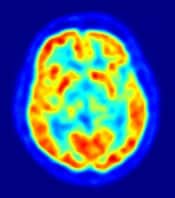 Evolution
Evolution
More on the Evolutionary Mystery of the Brain
Shortly after putting up our post from yesterday on the evolutionary mystery that is the human brain, we were driving to work and caught the tail end of a radio interview on NPR with journalist Steven Levy. He was talking about his visit to a 115,000-square-foot state-of-the-art Google data center. That’s the kind of place where some of the data that forms the computing “Cloud” lives. Chatting with host Steve Inskeep, Levy also referred to a journalistic coup he accomplished in 1978 when he discovered, in rather disheveled storage, Albert Einstein’s preserved and dissected brain:
You know, many, many years ago I went on almost a quest for Einstein’s brain, which was lost then. And I felt if I saw it, it might be an anti-climax. But when I actually did see it, it really opened up my eyes as a revelation. This is where, you know, the power of the atom came from and relativity and all those other things. And I had the same kind of experience inside that Google data center. Here was the ephemeral made real, you know, the Cloud really was something and it was something quite remarkable and breathtaking.

Levy was expressing the popular notion that creativity and ideas and inspiration come somehow from the brain — and that, in turn, ideas live in a material sense in the folds of the brain, just as data lives in servers in the Google data center.
We have a couple of reactions. First, the underlying assumption that the physical brain creates things — ideas — is only an assumption grounded in materialistic presuppositions. Levy reports looking in awe upon Einstein’s brain, but that’s just like looking at the telephone in your hand and gaping in wonder and amazement because the message you heard from the other end was so profound. We all know that the phone itself did not generate the message but merely received and conveyed it (Siri excluded in this example). With a faulty phone or a damaged brain, the link is broken and the voice falls silent or pours forth only static or nonsense.
Second, his comments about where “the power of the atom came from and relativity and all those other things” reminded us of A Meaningful World by Discovery Institute’s Benjamin Wiker and Jonathan Witt. Is it true that the intricacies of the atom came from Einstein’s brain, or is it the case instead that Einstein outlined a theory that describes or models what we know of reality? The latter, obviously. The only reason that someone can come up with such a theory in the first place is because the world is contingent and, according to Wiker and Witt (as well as Richards and Gonzalez in The Privileged Planet), knowable and meant to be known. If you trace the history of atomic theory, it builds on itself beautifully with layers of meaning, coherence, consistency, and complexity arising as each new piece is uncovered. These are hallmarks of design, and Einstein helped to uncover some of those features of the design.
Lastly — okay we have three thoughts on this, a third just popped into our mind as we were writing (hm!) — many of the transhumanists believe that there will come a point when we can upload our consciousness (the data from our brains) into a cloud, as Google does currently, or like in the movie The Matrix. This is a reductionist view — a naive one, we’d say. It assumes we are defined by bits of data. This is just as simplistic as the assumption that we are defined by chemistry. Epigenetics, among other things, is troubling for such reductionism. There is no reason to believe that consciousness arises from bits of data, although it is the stuff of some great science fiction stories about artificial intelligence.
Image credit: PET image of the human brain showing energy consumption/Wikipedia.


